Every magic trick, every magic routine needs a story. Just explaining to the participants what they can see, won't cut it. Here I present my steampunk patter for Dai Vernon's Cups and Balls routine.
Emanuel Chester
27 Jan. 2014
The Cups and Balls routine may be the oldest recorded magic routine in history. Some people say there are Egyptian hieroglyphs that depict this routine. Nowadays we find this routine among magicians as a sign of skill, but also in the streets as a hustle, a con game.
Most magicians perform this routine the same way as Dai Vernon does, for he is known to have improved the tricks, moves, and effects, introducing and teaching many subtleties. Some have started using chop cups to add a little magical oomph that they couldn't achieve by sleight of hand. However, few performers show this routine with their own patter, let alone one that doesn't describe each move as it is presented.
There is a reason why Dai Vernon describes each move: his persona is that of a teacher. When teaching, I probably use that exact same patter. But usually, when performing for an audience, I don't presume to teach anyone anything. I'm merely there to entertain.
That's why I came up with this patter. It fits my steampunk persona, which I use when performing street magic. It weaves the tale of 3 physicists. Below I will share this story, intertwined with the effects of the Cups and Balls routine. This doesn't teach you the secret of how that routine is done. I'm sure you can find it in a decent magic book. And if you can't, you can always hire me to teach you. ;)
You may have heard of the great scientists of our age: Leonardo da Vinci, Galileo Galileï, and Copernicus. We just call him Harry Copper.
They were so important, that they had their own studios. (Bring out the 3 cups.) Normal people didn't have studios: they could hardly afford a house. That shows that our physicists were extra special.
(Dai Vernon and many others simply introduce the 3 balls here. We can do the same, or we can use some magic to make them appear. Simply introducing them makes them seem harmless, which makes for a greater effect later on. My patter continues assuming the 3 cups are in a row upside down on the table, each having a ball on top of them.)
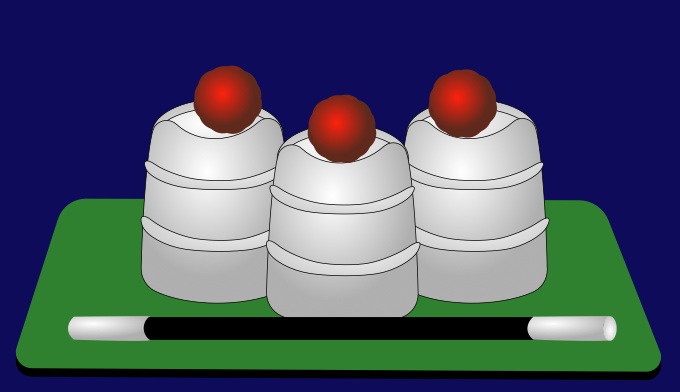
Why were they so special? Well, each time their employer would come by, they would disappear. See: first Leonardo disappears (throw the ball that represents Da Vinci into your empty hand and make it disappear). Next, Galileo disappears (throw the ball that represents Galileï into your empty hand and make it disappear).
Harry Copper however, was too slow. (Show Copernicus' ball in your hand.) His employer came by and Harry didn't have enough time to get away. He was smart, though: he had a secret door in his studio, and managed to sneak out anyway. (Vanish the ball.)
And when their employers left, our sneaky scientists would return, each to their own studio. (Turn over the cups, showing each contains a ball.)
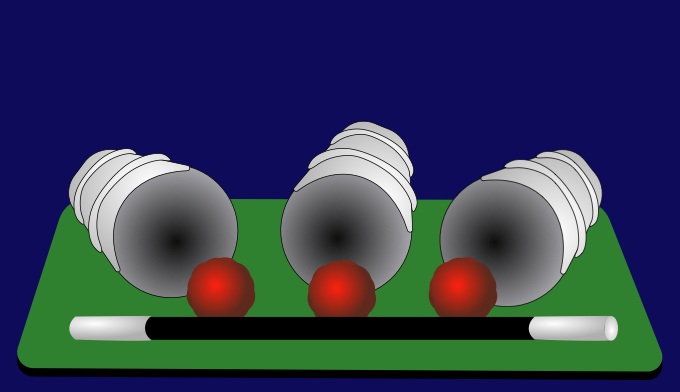
Now at some point, something happened. You may have heard of this: mr. H.G.Wells invented a time machine. (Cover each ball with their own cup, and secretly set them up for the next effect.) And that time machine let our physicists join up with each other.
Watch: mr. Galileï can leave his studio without being seen, and visit mr. Harry Copper. (Lift the left 2 cups and show the middle ball joined the one under the left cup.)
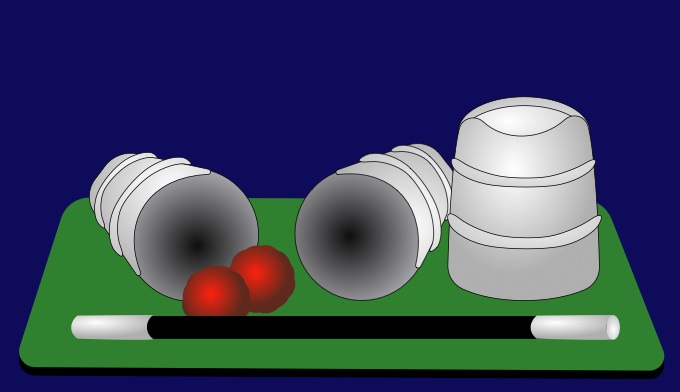
Now time travel has its limitations: mr. Da Vinci can't go forward in time... (replace the middle ball and put all cups upright over their ball), but mr. Galileï can go and visit Leonardo! (Lift the right 2 cups and show that the middle ball joined the one under the right cup.)
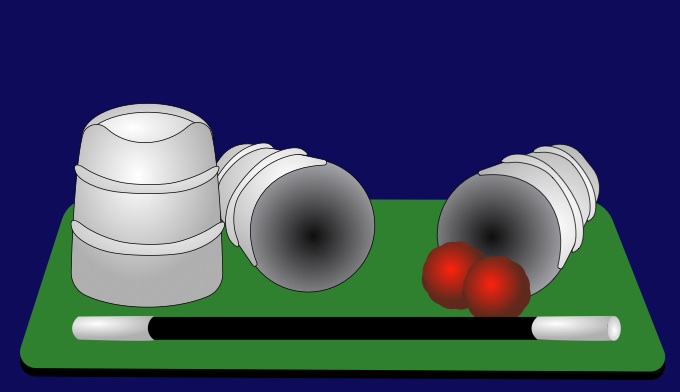
And sometimes, Galileo just wants to have a party. With science speak, and poker, and beer! (Cover each ball with their own cup, secretly setting them up for the next effect.) So he'll take his time machine, and fetch his colleagues. (Show the 3 balls assembled under the middle cup, show the outside cups empty.).
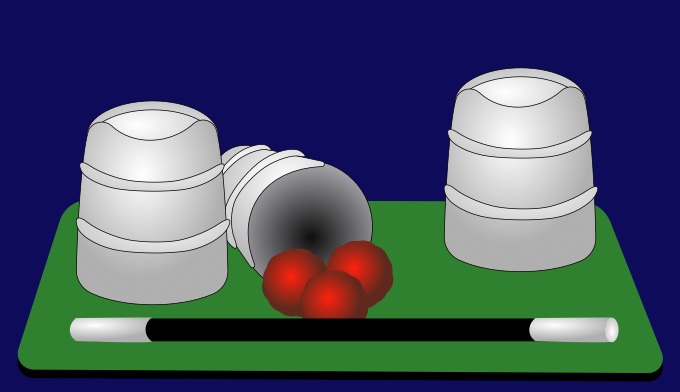
But I discovered their secret. Well... not as much discovered, as it was handed down to me by my great grandfather's best friend's neighbour's parrot. He made a good schnitzel. (Place the cups on top of each other, preparing them for the ball penetration. Pick up the top cup, and stick the magic wand inside.) You see, as with many time machines, it's also relative in dimension and space, which means, in laymen's terms, that it's bigger on the inside. (Execute the illusion that shows that the wand goes into the cup deeper than fits the cup's height when measured from the outside. Return the cup, stacking it on top of the others.)
That lets us drop mr. Da Vinci straight through the top, see? (Execute the penetration illusion through the top cup.) And if we add mr. Galileï, they are heavier, so they drop down a story, see? (Execute the penetration illusion of 2 balls through the 2 top cups.) And finally, if we add mr. Copper... (Show that all 3 balls reassembled under the bottom cup.)
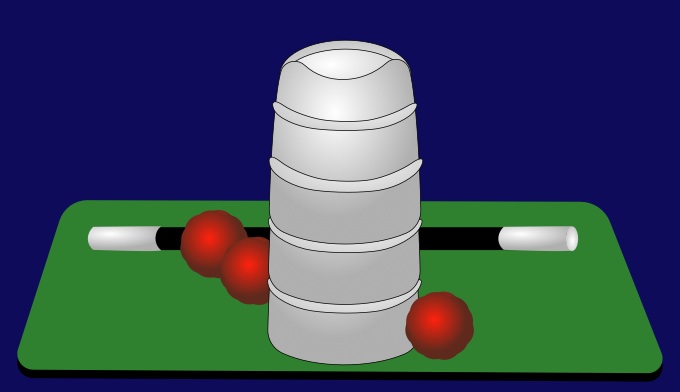
(Set the balls out on the table, and place the cups on the table behind them. Take the 2 outer cups in your hands.)
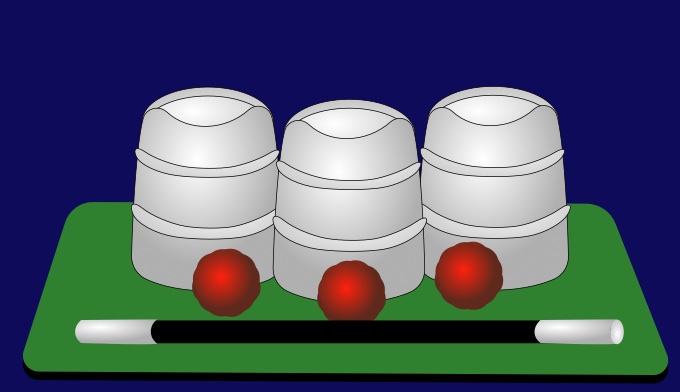
Something that very few people realise, though, is that this is only possible, when the time streams cross. And when they cross, the time machine passes through itself. (Show the illusion where one cup falls right through the other.)
(Place the cups back down in a row, opening down on the table. Place a ball on each cup.) And that means that when our physicists wish to escape from their employers, like Da Vinci from the Medici (drop that ball from the cup into your hand, place it under the cup), Galileo from the university dean (drop that ball from the cup into your hand, place it under the cup), and mr. Copper from the director of the telescopes company (drop that ball from the cup into your hand, shoot it under the cup from the side), instead of each of them winding up back in their own studio, they all return to Galileo's. With science speak, and poker, and beer.

Now it gets really weird when time machines aren't propelled by a time vortex... (set each cup upside down with the front of its rim on the ball, and the back of its rim on the table) but instead get propelled by a probability engine. Yes, like in the Hitchhiker's Guide to the Universe. (Drop each cup over its ball.)
For if we take mr. Da Vinci and transport them somewhere far far away (put that ball in your pocket), and if we do the same with mr. Galileï, and if we let Chief O'Brien beam Harry Copper to the surface of a planet, then who is left behind in the studios? That's right: it's madame La Curie, mr. Einstein, and mr. Edward Hubble. (Produce the bigger, differently coloured balls from under each cup. Some use fruit.).
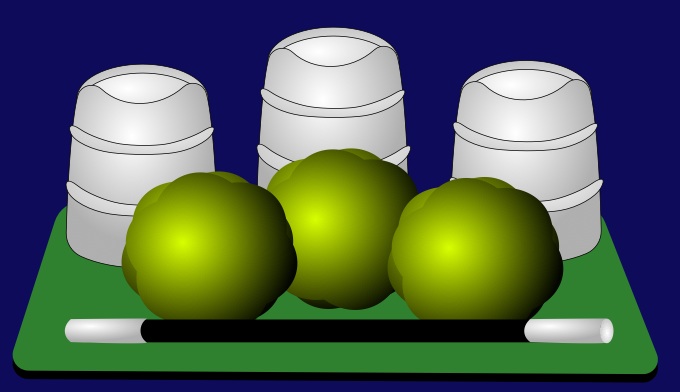
But what really amazes me every time, is this cameo by dr. Sheldon Cooper! (Lift up the middle cup to reveal the 4th differing production. I use an egg, some use a larger ball, David Copperfield used a mouse once.)
I choose to share my patters and stories not because I want you to copy them. Well... if you do I'd be flattered! But no, I want you to understand that we can come up with a story that fits our routines and the magic persona that we play when performing. My story must differ from yours, for I am a different person.
It takes just a little bit of effort, and just a little bit of time, to conjure up your own story, but you will see that it is totally worth it: you will be giving your audience something no other magician gave them. You will have made yourself unique, and their experience unforgettable.
What story would you devise for this routine?
Most magicians perform this routine the same way as Dai Vernon does, for he is known to have improved the tricks, moves, and effects, introducing and teaching many subtleties. Some have started using chop cups to add a little magical oomph that they couldn't achieve by sleight of hand. However, few performers show this routine with their own patter, let alone one that doesn't describe each move as it is presented.
There is a reason why Dai Vernon describes each move: his persona is that of a teacher. When teaching, I probably use that exact same patter. But usually, when performing for an audience, I don't presume to teach anyone anything. I'm merely there to entertain.
That's why I came up with this patter. It fits my steampunk persona, which I use when performing street magic. It weaves the tale of 3 physicists. Below I will share this story, intertwined with the effects of the Cups and Balls routine. This doesn't teach you the secret of how that routine is done. I'm sure you can find it in a decent magic book. And if you can't, you can always hire me to teach you. ;)
A Tale of 3 Physicists
You may have heard of the great scientists of our age: Leonardo da Vinci, Galileo Galileï, and Copernicus. We just call him Harry Copper.
They were so important, that they had their own studios. (Bring out the 3 cups.) Normal people didn't have studios: they could hardly afford a house. That shows that our physicists were extra special.
(Dai Vernon and many others simply introduce the 3 balls here. We can do the same, or we can use some magic to make them appear. Simply introducing them makes them seem harmless, which makes for a greater effect later on. My patter continues assuming the 3 cups are in a row upside down on the table, each having a ball on top of them.)

Why were they so special? Well, each time their employer would come by, they would disappear. See: first Leonardo disappears (throw the ball that represents Da Vinci into your empty hand and make it disappear). Next, Galileo disappears (throw the ball that represents Galileï into your empty hand and make it disappear).
Harry Copper however, was too slow. (Show Copernicus' ball in your hand.) His employer came by and Harry didn't have enough time to get away. He was smart, though: he had a secret door in his studio, and managed to sneak out anyway. (Vanish the ball.)
And when their employers left, our sneaky scientists would return, each to their own studio. (Turn over the cups, showing each contains a ball.)

Now at some point, something happened. You may have heard of this: mr. H.G.Wells invented a time machine. (Cover each ball with their own cup, and secretly set them up for the next effect.) And that time machine let our physicists join up with each other.
Watch: mr. Galileï can leave his studio without being seen, and visit mr. Harry Copper. (Lift the left 2 cups and show the middle ball joined the one under the left cup.)

Now time travel has its limitations: mr. Da Vinci can't go forward in time... (replace the middle ball and put all cups upright over their ball), but mr. Galileï can go and visit Leonardo! (Lift the right 2 cups and show that the middle ball joined the one under the right cup.)

And sometimes, Galileo just wants to have a party. With science speak, and poker, and beer! (Cover each ball with their own cup, secretly setting them up for the next effect.) So he'll take his time machine, and fetch his colleagues. (Show the 3 balls assembled under the middle cup, show the outside cups empty.).

But I discovered their secret. Well... not as much discovered, as it was handed down to me by my great grandfather's best friend's neighbour's parrot. He made a good schnitzel. (Place the cups on top of each other, preparing them for the ball penetration. Pick up the top cup, and stick the magic wand inside.) You see, as with many time machines, it's also relative in dimension and space, which means, in laymen's terms, that it's bigger on the inside. (Execute the illusion that shows that the wand goes into the cup deeper than fits the cup's height when measured from the outside. Return the cup, stacking it on top of the others.)
That lets us drop mr. Da Vinci straight through the top, see? (Execute the penetration illusion through the top cup.) And if we add mr. Galileï, they are heavier, so they drop down a story, see? (Execute the penetration illusion of 2 balls through the 2 top cups.) And finally, if we add mr. Copper... (Show that all 3 balls reassembled under the bottom cup.)

(Set the balls out on the table, and place the cups on the table behind them. Take the 2 outer cups in your hands.)

Something that very few people realise, though, is that this is only possible, when the time streams cross. And when they cross, the time machine passes through itself. (Show the illusion where one cup falls right through the other.)
(Place the cups back down in a row, opening down on the table. Place a ball on each cup.) And that means that when our physicists wish to escape from their employers, like Da Vinci from the Medici (drop that ball from the cup into your hand, place it under the cup), Galileo from the university dean (drop that ball from the cup into your hand, place it under the cup), and mr. Copper from the director of the telescopes company (drop that ball from the cup into your hand, shoot it under the cup from the side), instead of each of them winding up back in their own studio, they all return to Galileo's. With science speak, and poker, and beer.

Now it gets really weird when time machines aren't propelled by a time vortex... (set each cup upside down with the front of its rim on the ball, and the back of its rim on the table) but instead get propelled by a probability engine. Yes, like in the Hitchhiker's Guide to the Universe. (Drop each cup over its ball.)
For if we take mr. Da Vinci and transport them somewhere far far away (put that ball in your pocket), and if we do the same with mr. Galileï, and if we let Chief O'Brien beam Harry Copper to the surface of a planet, then who is left behind in the studios? That's right: it's madame La Curie, mr. Einstein, and mr. Edward Hubble. (Produce the bigger, differently coloured balls from under each cup. Some use fruit.).

But what really amazes me every time, is this cameo by dr. Sheldon Cooper! (Lift up the middle cup to reveal the 4th differing production. I use an egg, some use a larger ball, David Copperfield used a mouse once.)
Afterthoughts
I choose to share my patters and stories not because I want you to copy them. Well... if you do I'd be flattered! But no, I want you to understand that we can come up with a story that fits our routines and the magic persona that we play when performing. My story must differ from yours, for I am a different person.
It takes just a little bit of effort, and just a little bit of time, to conjure up your own story, but you will see that it is totally worth it: you will be giving your audience something no other magician gave them. You will have made yourself unique, and their experience unforgettable.
What story would you devise for this routine?
Wouldn't you like your events to make a lasting impression?

Send in this contact form, or mail me at emanuel.chester@protonmail.com.